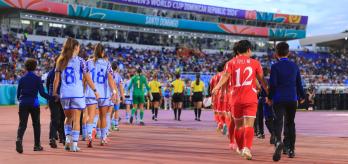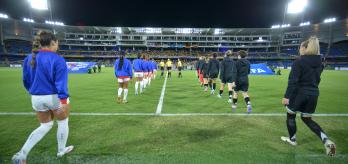Key take-aways
-
With one of the oldest squads at the tournament (28.6 years on average), defending champions USA relied on experience to deliver success, whilst Spain, with an average age of 25.1 years, banked on youth.
-
Less than half of the players selected play for clubs in the association represented, whilst the percentages of footballers playing in a country for nations with well-developed leagues such as USA, Italy, Spain, England and Germany, are logically high.
-
England employs the highest number of players selected for the World Cup, followed by USA and Spain. The clubs in these countries employ more than a third of the players selected, a proportion that exceeds half if France and Italy are also thrown into the equation.
Demographic analysis of the FIFA Women’s World Cup 2023 squads
The ninth FIFA Women's World Cup took place between 20 July and 20 August in Australia and New Zealand. Thirty-one teams looked to dethrone the United States, the two-time defending champions and four-time winners. This study analyses the characteristics of national team squads in terms of the age of the players, the clubs and leagues to which they belong, their clubs at the start of their careers at senior level, as well as any appearances they may have made for youth national teams.
The 32 qualified teams represented all of the six confederations, ranging from 12 national teams for UEFA to one for the OFC, the co-hosts of New Zealand. In terms of the number of participations in World Cup final tournaments, seven teams have never missed out (Germany, Brazil, Japan, Nigeria, Norway, Sweden and USA). Conversely, eight teams took part for the very first time (Haiti, Morocco, Panama, Philippines, Portugal, Ireland, Vietnam and Zambia).
Age
On average, the players selected for the 2023 FIFA Women's World Cup were 26.8 years old. At confederation level, the figures ranged from 25.9 for CONCACAF associations’ teams to 27.4 for the CONMEBOL ones. The age group of players aged 21 or under represented 14.9% of all footballers selected, with a maximum of 23.2% at CONCACAF level and a minimum of 8.7% for the OFC (New Zealand), closely followed by UEFA (10.1%).
By national team, the average age varied from a low of 22.9 for Haiti to a high of 29.4 for South Korea. The United States had the fourth most experienced squad of the 32 participating member associations, with an average age of 28.6 years. The highest proportions by age group were recorded for Haiti for players aged 21 or under (47.8%), Zambia for those aged between 22 and 25 (52.2%), the Republic of Ireland for those aged between 26 and 29 (52.2%) and South Korea for those aged 30 or over (52.2%).
Employment clubs and leagues
The UEFA (56.5%) and AFC (53.6%) national teams are the only ones where the majority of footballers play for a club in the association represented. In total, just 47.4% of players are active in the country represented, which bears witness to the strong internationalisation of the labour market for top-level female players. The OFC, represented by New Zealand, is an extreme case, with just four of the 23 footballers called up playing for domestic teams.
The percentage of footballers playing for clubs in the association represented varied greatly from team to team. On one hand, Jamaica did not call up any players under contract to an affiliated national club. On the other hand, the percentage of footballers selected playing for affiliated clubs from the represented member association is particularly high for the USA, Vietnam, as well as for four European countries with more-developed domestic leagues (Italy, Spain, England and Germany).
With 104 players registered with affiliated national clubs, England led participating member associations for the employment of players selected for the 2023 FIFA Women’s World Cup. The United States (83 players) and Spain (75) complete the podium. Clubs in these three countries alone employ more than a third of the players selected, a proportion that rises to more than half if France and Italy are also taken into account.
In terms of the main clubs of employment, 2023 UEFA Women’s Champions League winners FC Barcelona top the table with 16 players selected for the World Cup. These players represent no less than seven different member associations. The top fourteen places are filled exclusively by teams from UEFA member associations, while the highest-ranked non-European clubs are Saprissa in Costa Rica and Incheon in South Korea (8 players for both).
Debut clubs at senior level
The "development club" was defined as the first club at which the World Cup footballers played official minutes at a senior level. In total, just under eight out of ten players began their careers with a club in the association represented. The highest figure was recorded at UEFA level (94.6%), where only the Republic of Ireland selected a consistent number of players who started their careers abroad, more specifically at English clubs.
In the case of Jamaica and the Philippines, none of the players began their careers at adult level in the association represented. This surprising finding reflects a strategy focused on selecting players who grew up abroad. The Jamaican players were mainly born in the USA (12) and England (5), while the Philippine players were in the majority born in the USA (16).
The Canadian club of Toronto Lady Lynx topped the table regarding the rankings for clubs where players selected for the 2023 FIFA Women’s World Cup made their debut at adult level. The Swiss team of FC Zürich and the Japanese team of Nippon TV Tokyo Verdy completed the podium. The teams at the top are exemplary in terms of player development. They also include some highly competitive clubs such as Arsenal, Washington Spirit and Olympique Lyonnais.
An analysis of the proportion of footballers who also played for the U17 to U20 youth teams of the association represented at adult level shows how important youth teams are in supplying the senior team. In total, just over two-thirds of the players selected have international experience for the association represented at youth level. This proportion is less than half at CAF level only, which reflects the relative breakdown of the local training system and the frequent repatriation of players who have grown up abroad.
All the footballers in the England squad have played for the Three Lions' national youth teams. This result highlights the importance of the national youth teams in the development of England’s footballers, as well as in the building up of the senior team. Four other UEFA nations have percentages above 90%, whilst this proportion is also high for Japan and New Zealand. In contrast, Morocco, the Philippines, South Africa and the Republic of Ireland, in particular, made little use of the youth national teams’ pathway.
Conclusion
This report shows the diversity of the strategies followed by the national associations of the teams qualified for the 2023 FIFA Women’s World Cup in making up their squads. In terms of age, with the fourth oldest squad at the tournament, the two-time defending champions USA banked on experience (28.6 years on average, with only 8.7% aged 21 or under). In comparison, eventual winners Spain banked on youth, with an average age of 25.1 and 56.5% of players aged 25 or under.
Less than half of the players selected play for clubs in the association represented, reflecting a well-established process of internationalisation of the labour market for top-level female footballers. The percentages of female footballers playing in the country are logically high for nations with well-developed professional leagues, such as the United States, Italy, Spain, Germany and England. Vietnam also deserves to be mentioned with 22 of the 23 squad members playing for domestic clubs.
England is the leading country of employment for World Cup players (104), followed by the USA (83) and Spain (75). The clubs in these three associations employ more than a third of the footballers selected, a proportion that exceeds half if France and Italy are also taken into consideration. The biggest employer is Barcelona (16 players representing seven national teams), while Toronto's Lady Lynx have launched the adult careers of the largest number of 2023 FIFA Women’s World Cup players (11).
Different strategies also exist when it comes to the footballing origins of the players called up. Generally, almost eight out of ten players began their careers with a club in the association represented. However, some countries relied almost exclusively on players born, raised and/or trained abroad. While this strategy has enabled them to qualify for the 2023 World Cup, in the longer term, as for any nations, the development of effective national training programmes could help to further raise their competitiveness.



























